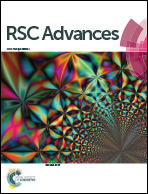Photoinduced change in the shape of azobenzene-based molecular glass particles fixed in agar gel†
Abstract
Photomechanical behaviours of photochromic materials have been attracting a great deal of attention. Here we report a new photomechanical phenomenon, one in which azobenzene-based molecular glass particles fixed in an isotropic agar gel environment became elongated and formed string-like structures upon being irradiated with a linearly polarized laser beam. An analysis in three dimensions confirmed the direction of the elongation to be parallel to the polarization direction of the incident beam. The phenomenon could be explained by a photoinduced vibration and/or transport of the molecules parallel to the polarization direction of the incident beam to generate a force exerted by the particles to push the surrounding gel away in the direction parallel to the polarization direction. Photoinduced elongation was promoted by a high Tg for the material but impeded by the introduction of bulky substituents at both ends of the azobenzene moiety. Such elongation could also be induced by using linearly polarized incoherent LED light, suggesting that the coherence of the incident beam was irrelevant to the photomechanical behaviours.


 Please wait while we load your content...
Please wait while we load your content...